General Examination for Women
The General Examination for Women was an examination of the University of London first held in May 1869 that enabled women to receive a Certificate of Proficiency from the University but not a degree. It was a precursor to the award of degrees to women by the University which did not happen until a decade later. The first nine candidates to take the exam are sometimes known as "the London Nine".
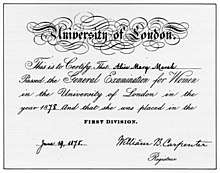 Certificate awarded to Alice Marsh in 1878[1] | |
| Developer / administrator | University of London |
|---|---|
| Knowledge / skills tested | Humanities and sciences |
| Purpose | Degree level qualification for women |
| Year started | 1869 (admission 1868) |
| Year terminated | 1878 |
| Languages | English |
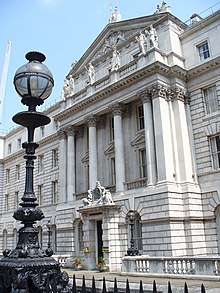
The examination
Candidates for the General Examination for Women were admitted to study at the University of London from 1868.[2] The examination was first held in May 1869 with nine candidates participating. The results were assessed on 15 May 1869, at Somerset House on the Strand, by 17 male examiners.[2] Although the exam could be taken from the age of 17, the average age of the candidates was 21.[3]
In order to receive their certificate, the candidates had to pass a minimum of six papers from, "Latin, English Language, English History, Geography, Mathematics, Natural Philosophy, two from Greek, French, German and Italian, and either Chemistry or Botany".[2] The questions included an essay on the character of Queen Elizabeth, a request to enumerate "the principal rivers in North America", and the calculation of the square root of 384524.01. On the advice of the Home Office, a "female attendant" or matron was made available in case the candidates should become over-excited by being brought to London for examination.[1][2]
Despite the examination being as difficult as the existing Matriculation Examination, only a Certificate of Proficiency was issued to the successful candidates, rather than a degree.[2]
The "London Nine"
The first nine candidates in 1869, sometimes known as "the London nine", were:[2][4]
- Marian Belcher (1849–1898) became headmistress of Bedford High School.
- Louise Hume von Glehn (1850–1936) became Louise Hume Creighton and wrote popular historical biographies and campaigned for working women and in the suffrage movement.
- Hendilah Lawrence
- Sarah Jane Moody (1844–1916) founded a preparatory school in Guildford with her sisters.
- Eliza Orme (1848–1937) became the first woman to earn a law degree in England and was active in the prison reform and suffrage movements.
- Kate Spiller (1847–1915) joined her local school board in Bridgwater, Somerset.
- Mary Anna Baker Watson (1828–1901) became a governess and school teacher in Northamptonshire.
- Isabella de Lancy West (studied at Bedford College)
- Susannah Wood (1844–1939) graduated with a BSc and taught mathematics. She became the vice-principal of the Cambridge Training College for Women (later Hughes Hall, Cambridge).
All passed with honours apart from Belcher, Lawrence, and Baker-Watson who did not pass. Belcher re-sat and passed in 1870.[2]
The suffrage campaigner and translator Henrietta Frances Lord passed the exam in 1872.[5]
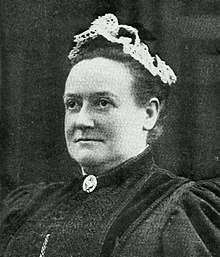 Marian Belcher[6]
Marian Belcher[6]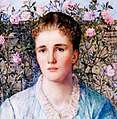 Louise Creighton aged 27 by Bertha Johnson, 1878.[7]
Louise Creighton aged 27 by Bertha Johnson, 1878.[7]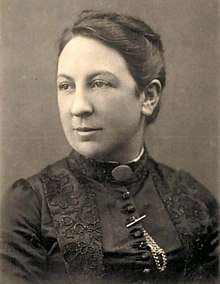 Eliza Orme[8]
Eliza Orme[8]
Numbers
Over the subsequent decade until the exam was last held in 1878, over 264 candidates took the exam, some of whom were re-takes or additional qualifications meaning that the actual number of individual women who participated was somewhat lower than 264.[2][3] Of these 139 passed, of whom 53 passed with honours.[2]
Of the 139:[3]
- 44 were pupils of Cheltenham Ladies College
- 40 prepared by private study or tuition
- 28 were pupils of the North London Collegiate School
- 27 attended other schools and institutions.
In 1878, there were 42 candidates of whom 24 passed.[1]
Legacy
The certificate ceased to be offered from 1878 as it provided evidence that there was no necessity to examine men and women separately.[3] Women were allowed to study for University of London degrees from that year and the women-only colleges of Westfield and Royal Holloway were founded in 1882 and 1886 respectively. In 1895, 10% of the university's graduates were women, and 30% by 1900.[2]
See also
References
- Harte, Negley. (1986). The University of London 1836-1986. An Illustrated History. London: Athlone Press. p. 115. ISBN 0-485-11299-X.
- "Oh Pioneers! Lives and legacies of London's women undergraduates, 1868-1928" by Philip Carter in Past and Future, Institute of Historical Research, No. 23 (Spring/Summer 2018), pp. 16–17. (Abbreviated online blog version here)
- Willson, Francis Michael Glenn. (2004). The University of London, 1858-1900: The Politics of Senate and Convocation. Woodbridge: Boydell Press. pp. 110–112. ISBN 1843830655.
- The Calendar for the Year 1873. London: Taylor & Francis. 1873. p. 494.
- Crawford, Elizabeth. (1999). The Women's Suffrage Movement: A Reference Guide, 1866–1928. London: Routledge. p. 357. ISBN 0415239265.
- Ayres, Linda. "Marian Belcher - Second Head Mistress of Bedford High School - Foster Hill Road Cemetery". Fosterhillroadcemetery.co.uk. Retrieved 30 October 2018.
- Covert, James Thayne. (2000) A Victorian Marriage: Mandell and Louise Creighton. London: Hambledon & London. p. viii. ISBN 978-1852852603
- Eliza Orme. Leslie Howsam, First Hundred Years, 7 August 2015. Retrieved 29 October 2018.
Further reading
- Myers, Christine (2010). University Coeducation in the Victorian Era: Inclusion in the United States and the United Kingdom. Springer. ISBN 9780230109933.
- Rowold, Katharina (2011). The Educated Woman: Minds, Bodies, and Women's Higher Education in Britain, Germany, and Spain, 1865-1914. Routledge. ISBN 9781134625833.
- May Sheffield, Suzanne Le (2006). Women and Science: Social Impact and Interaction. Rutgers University Press. ISBN 9780813537375.